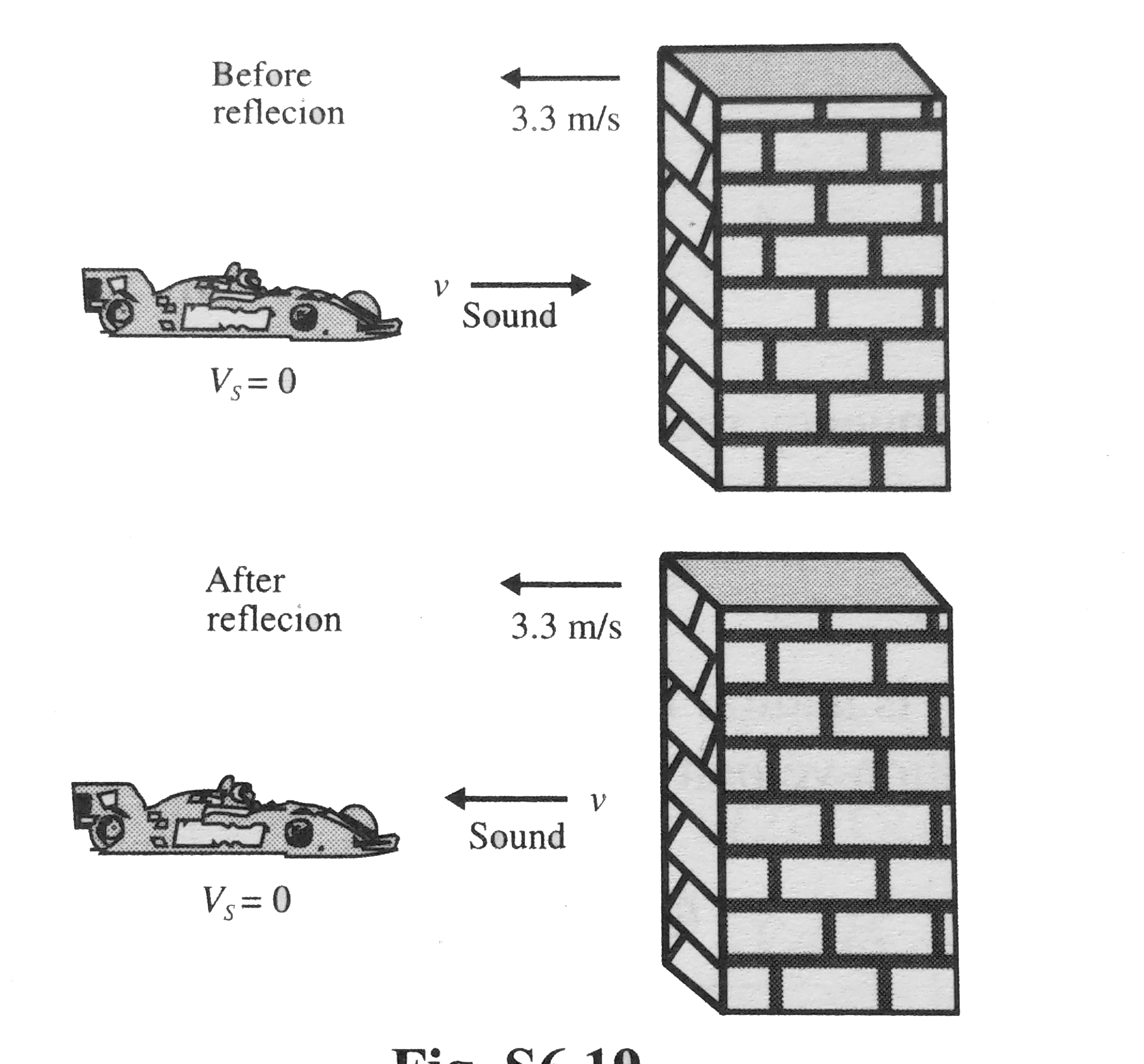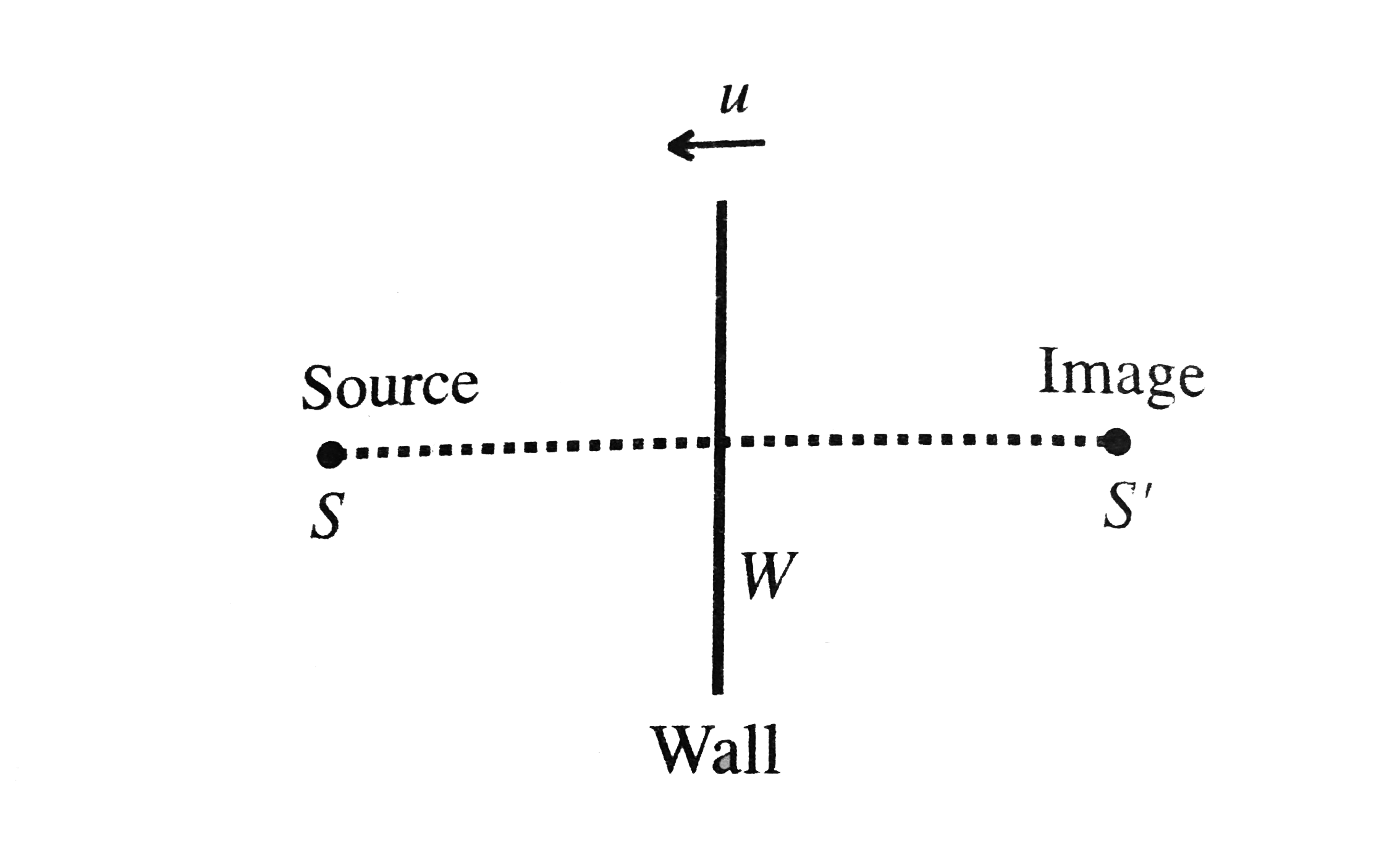A driver in a stationary car blows a horn which produces monochromatic sound waves of freqeuncy 1000 Hz normally towards a reflecting wall. The wall approaches the car with a speed of 3.3ms.
The frequency of sound reflected from wall and heard by the driver is 1020 Hz
The frequency of sound reflected from wall and heard by the deriver is 980 Hz
The percentage increase in frequency of sound after reflection from wall is 2%
The percentage decrease in freqeuncy of sound after reflection from wall is 2%
The correct Answer is:A, C

f'=f(v+vwallv−vwall)
f'=1000(340+3.3340−3.3)=1020Hz
f'−ff×100=△ff×100=2%
Topper's Solved these Questions
- BOOK - CENGAGE PHYSICS ENGLISHCHAPTER - SOUND WAVES AND DOPPLER EFFECTEXERCISE - Assertion-Reasoning24videos
SOUND WAVES AND DOPPLER EFFECT
- BOOK - CENGAGE PHYSICS ENGLISHCHAPTER - SOUND WAVES AND DOPPLER EFFECTEXERCISE - Comprehension144videos
SOUND WAVES AND DOPPLER EFFECT
- BOOK - CENGAGE PHYSICS ENGLISHCHAPTER - SOUND WAVES AND DOPPLER EFFECTEXERCISE - Single Correct252videos
SOUND WAVES AND DOPPLER EFFECT
- BOOK - CENGAGE PHYSICS ENGLISHCHAPTER - RIGID BODY DYNAMICS 2EXERCISE - Interger2videos
RIGID BODY DYNAMICS 2
- BOOK - CENGAGE PHYSICS ENGLISHCHAPTER - SUPERPOSITION AND STANDING WAVESEXERCISE - Comprehension Type5videos
SUPERPOSITION AND STANDING WAVES
Similar Questions
 A driver in a stationary car horns which produces monochromatic sound waves of frequency n=1000Hz, normally towards a reflecting wall. If the wall approaches the car will a velocity u=3.3ms, calculate the frequency of sound reflected from wall and heard by the driver. What is the percentage change of sound frequency of reflection from the wall?View Solution
A driver in a stationary car horns which produces monochromatic sound waves of frequency n=1000Hz, normally towards a reflecting wall. If the wall approaches the car will a velocity u=3.3ms, calculate the frequency of sound reflected from wall and heard by the driver. What is the percentage change of sound frequency of reflection from the wall?View SolutionA driver in a stationary car horns which produces sound waves having frequency 2000 Hz. The waves are directed normally towards a reflecting wall. If the wall approaches the car with a velocity u = 3.3 m/s. The change in the frequency of sound after reflection from the wall is x%. Then x
View SolutionA stationary source emits the sound of frequency f0=492 Hz. The sound is reflected by a large car approaching the source with a speed of 2ms−1. The reflected signal is received by the source and superposed with the original. What will be the beat frequency of the resulting signal in Hz? (Given that the speed of sound in air is 330ms−1 and the car reflects the sound at the frequency it has received).
View SolutionBus moving with speed v forwards a stationary wall. it produces sound of frequency f=420Hz.Theheardequencyofref≤ctedsoundomwallbydriveris490 Hz.Calca––tethespeedvofbus.Thevelocityofsound∈airis330 m/s.
View SolutionA car blowing a horn of frequency 350 Hz is moving normally towards a wall a speed of 5 m/s The beat frequency heard by a person standing between the car and wall is (speed of sound in air =350 m/s )
View SolutionA police car horn emits a sound at a frequency 240 Hz. When the car is at rest. If the speed of the sound is 330 m/s the frequency heard by an observer who is approching the car at a speed of 11 m/s is
View Solutiona bus is moving towards and stationary observer with speed 20 m/s blows a horn of frequency 200 Hz. the frequency of sound heard by the observer is approximately ( take speed of sound 320 m/s)
View SolutionA bat flies perpendicularly towards a wall with a speed of 6 m/s, emitting sound of frequency 450 kHz. What is the frequency of the wave reflected from the wall that it will hear? Given c=340ms?
View SolutionA bat flies perpendicularly towards a wall with a speed of 6 m/s, emitting sound of frequency 450 kHz. What is the frequency of the wave reflected from the wall that it will hear? Given c=340ms?
View SolutionA source of sound of frequency 1000 Hz moves to the right with a speed of 32ms relative to the ground. To its right there is a reflecting surface moving to the left with a speed of 64ms relative to the ground. Take the speed of 64ms. Relative to the ground. Take the speed of sound in air to be 332ms and find
(a) The wavelength of the sound emitted in air by the source,
(b) the number of waves per second arriving at the reflecting surface,
(c ) The speed of the reflected waves and
(d) The wavelength of the reflected waves.View Solution

